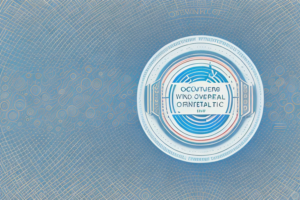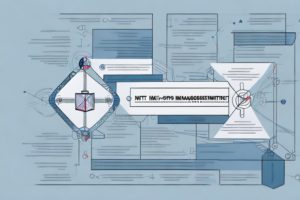What are the four components of ERM?

Four interconnected circles
Enterprise Risk Management (ERM) is a comprehensive approach to identifying, assessing, and managing risks faced by organizations. It involves developing a cohesive and integrated strategy to deal with the risks that an organization faces. ERM is a process-based approach that emphasizes risk management as an ongoing activity that requires constant attention and monitoring. In this article, we will explore the basics of ERM, its importance, and how to implement it in your organization.
Understanding the basics of Enterprise Risk Management (ERM)
ERM is an approach that identifies, assesses, and manages risks that can impact an organization’s ability to achieve its objectives. It is built upon a solid foundation that supports effective communication, collaboration, and alignment of risk management activities with the organization’s strategic objectives.
ERM is a cyclical process that includes four main components: Risk Identification, Risk Assessment, Risk Treatment, and Monitoring and Review. Let’s look at each component in more detail.
The first component of ERM is Risk Identification. This involves identifying potential risks that could impact the organization’s objectives. This can be done through various methods such as brainstorming sessions, risk assessments, and analyzing historical data. It is important to identify all potential risks, even those that may seem unlikely, to ensure that the organization is fully prepared.
The second component is Risk Assessment. Once risks have been identified, they need to be assessed to determine their likelihood and potential impact. This involves analyzing the probability of the risk occurring and the potential consequences if it does. This information is used to prioritize risks and determine which ones require the most attention and resources.
The importance of ERM in today’s business world
In today’s complex business environment, organizations face a wide range of risks that can impact their profitability, reputation, and ability to deliver products and services. These risks can be internal or external and can vary in their severity, likelihood, and impact. Effective ERM helps organizations to identify, assess, and manage risks proactively, leading to improved decision-making and reduced uncertainty. It also helps organizations to respond quickly to emerging risks and take advantage of opportunities that arise.
One of the key benefits of ERM is that it enables organizations to align their risk management strategies with their overall business objectives. By taking a holistic approach to risk management, organizations can ensure that their risk management efforts are focused on the areas that are most critical to their success. This can help organizations to prioritize their resources and allocate them more effectively, resulting in better risk management outcomes.
Another important aspect of ERM is that it helps organizations to comply with regulatory requirements and industry standards. Many industries are subject to a wide range of regulations and standards that govern their operations, and failure to comply with these requirements can result in significant penalties and reputational damage. Effective ERM can help organizations to identify and address compliance risks proactively, reducing the likelihood of non-compliance and associated penalties.
Identifying the key risks and challenges faced by organizations
The first step in implementing ERM is to identify the risks faced by the organization. This involves analyzing the internal and external environment and identifying potential risks that could impact the organization’s objectives. Once identified, these risks are assessed in terms of their likelihood and potential impact. Common risks facing organizations include financial risk, operational risk, strategic risk, reputational risk, and regulatory risk.
After identifying the risks, the next step is to prioritize them based on their potential impact and likelihood. This helps organizations to focus their resources on managing the most critical risks first. It is also important to regularly review and update the risk assessment to ensure that new risks are identified and managed appropriately.
Implementing ERM can also present challenges for organizations. One of the biggest challenges is getting buy-in from all levels of the organization. ERM requires a cultural shift towards risk management, which can be difficult to achieve. Additionally, ERM can be resource-intensive, requiring significant time and financial investment. However, the benefits of ERM, such as improved decision-making and risk mitigation, make it a worthwhile investment for organizations.
The role of risk assessment in ERM
Risk assessment is the process of evaluating the likelihood and impact of identified risks. It involves developing a risk matrix that assigns a value to each risk based on its likelihood and impact. This helps organizations to prioritize risks and allocate resources appropriately. Risk assessment is an ongoing process that should be revisited periodically as the organization’s risk profile changes.
One of the key benefits of risk assessment is that it enables organizations to identify potential risks before they occur. By proactively identifying and assessing risks, organizations can take steps to mitigate or avoid them altogether. This can help to minimize the impact of risks on the organization and reduce the likelihood of costly disruptions to operations.
Another important aspect of risk assessment is that it helps organizations to comply with regulatory requirements. Many industries are subject to regulations that require them to identify and manage risks in a systematic way. By conducting regular risk assessments, organizations can demonstrate to regulators that they are taking a proactive approach to risk management and are committed to ensuring the safety and well-being of their stakeholders.
Developing an effective risk management strategy for your organization
After identifying and assessing risks, organizations need to develop a risk management strategy that aligns with their overall business objectives. This involves developing risk treatment plans that detail how each risk will be addressed. Risk treatment plans can include risk mitigation, risk transfer, risk avoidance, and risk acceptance. Once the risk treatment plans have been developed, they are implemented and monitored.
It is important for organizations to regularly review and update their risk management strategy to ensure it remains effective and relevant. This includes identifying new risks that may arise and assessing the effectiveness of current risk treatment plans. By regularly reviewing and updating their risk management strategy, organizations can better protect themselves from potential threats and ensure the long-term success of their business.
Implementing ERM processes and procedures across your organization
ERM is a collaborative effort that involves all employees in the organization. It requires a clear framework that defines roles and responsibilities for risk management activities. ERM processes and procedures should be documented and communicated to all employees to ensure a consistent approach to risk management across the organization.
One important aspect of implementing ERM processes and procedures is to establish a risk appetite statement. This statement outlines the level of risk the organization is willing to accept in pursuit of its objectives. It helps to guide decision-making and ensures that risk management activities are aligned with the organization’s overall strategy.
Another key component of ERM is monitoring and reporting. Regular monitoring of risks and their associated controls is necessary to ensure that the organization is effectively managing its risks. Reporting on risk management activities and their outcomes is also important for accountability and transparency, both internally and externally.
Measuring the success of your ERM program – Key performance indicators to track
Measuring the success of an ERM program is essential to ensure its ongoing effectiveness. Key performance indicators (KPIs) should be established to track the progress of the ERM program. These KPIs should be aligned with the organization’s overall business objectives and should be regularly monitored and reported.
One important KPI to track is the number of identified risks that have been mitigated or eliminated. This can help demonstrate the effectiveness of the ERM program in identifying and addressing potential risks. Another KPI to consider is the level of employee engagement in the ERM program. This can be measured through surveys or other feedback mechanisms to gauge how well employees understand and participate in the program.
It’s also important to track the financial impact of the ERM program. This can include the cost savings from risk mitigation efforts, as well as any potential revenue growth opportunities that were identified and pursued as a result of the program. By tracking these financial KPIs, organizations can demonstrate the tangible benefits of their ERM program to stakeholders and decision-makers.
Addressing emerging risks and adapting your ERM program to changing circumstances
As the business environment changes, new risks may emerge that require the organization to adapt its ERM program. Organizations should maintain a proactive approach to risk management and be prepared to respond quickly to emerging risks. This involves ongoing monitoring and review of the risk profile, as well as regular updates to the risk management strategy and risk treatment plans.
One way to address emerging risks is to conduct scenario planning exercises. These exercises involve identifying potential future events or situations that could impact the organization and developing plans to mitigate the associated risks. By anticipating and preparing for potential risks, organizations can be better equipped to respond quickly and effectively when they arise.
The benefits of a proactive ERM approach – Mitigating risks before they occur
A proactive approach to ERM enables organizations to mitigate risks before they occur. This reduces the likelihood and impact of risks and leads to improved decision-making and resource allocation. A proactive approach also helps organizations to identify opportunities to improve their business processes and reduce costs.
Furthermore, a proactive ERM approach can enhance an organization’s reputation and increase stakeholder confidence. By demonstrating a commitment to risk management, organizations can build trust with customers, investors, and other stakeholders. This can lead to increased business opportunities and improved financial performance.
Challenges and limitations of ERM – Overcoming major obstacles
Despite its many benefits, ERM also presents several challenges and limitations. These include resistance to change, lack of resources, and inadequate risk management culture. To overcome these obstacles, organizations must commit to a long-term approach to risk management and foster a risk-aware culture throughout the organization.
Another challenge of ERM is the difficulty in identifying and assessing all potential risks. Some risks may be hidden or not immediately apparent, making it challenging to develop effective risk management strategies. To address this, organizations can conduct regular risk assessments and engage with stakeholders to identify potential risks.
In addition, ERM can be complex and time-consuming to implement, especially for larger organizations with multiple departments and business units. This can lead to resistance from employees who may view ERM as an additional burden on their workload. To overcome this, organizations can provide training and support to employees to help them understand the benefits of ERM and how it can improve their work processes and outcomes.
Case studies and examples of successful ERM implementation
Many organizations have successfully implemented ERM and realized its benefits. Case studies and examples of successful ERM implementation can provide valuable insights into the best practices and lessons learned from these organizations.
One example of a successful ERM implementation is at XYZ Corporation. They implemented ERM by first identifying all potential risks and then developing a risk management plan to address each one. This allowed them to proactively manage risks and avoid potential losses. As a result, they were able to increase their profitability and improve their overall business performance.
Another example is at ABC Company, where they implemented ERM by creating a risk management committee that included representatives from all departments. This allowed for a more comprehensive and collaborative approach to risk management. They also regularly reviewed and updated their risk management plan to ensure it remained relevant and effective. This helped them to better manage risks and improve their decision-making processes.
Future trends in ERM – Emerging technologies and best practices to watch out for
ERM is an evolving field that is constantly changing. Emerging technologies such as artificial intelligence and blockchain are expected to play a significant role in the future of ERM. Organizations should stay up-to-date with the latest trends and best practices in ERM to ensure they remain competitive and resilient in the face of new risks.
In conclusion, ERM is a comprehensive approach to identifying, assessing, and managing risks faced by organizations. It is a cyclical process that includes four main components: Risk Identification, Risk Assessment, Risk Treatment, and Monitoring and Review. Implementing ERM requires a proactive approach, a culture of risk awareness, and ongoing monitoring and review. Organizations that implement ERM can realize significant benefits, including improved decision-making, reduced uncertainty, and increased resilience in the face of new risks.



